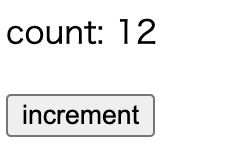最小虚拟 DOM
虚拟 DOM 用于什么?
通过在上一章中引入响应式系统,我们能够动态更新屏幕.让我们再次查看当前渲染函数的内容.
const render: RootRenderFunction = (vnode, container) => {
while (container.firstChild) container.removeChild(container.firstChild)
const el = renderVNode(vnode)
hostInsert(el, container)
}有些人可能在上一章中注意到这个函数中有很多浪费.
看看游乐场.
const app = createApp({
setup() {
const state = reactive({ count: 0 })
const increment = () => state.count++
return function render() {
return h('div', { id: 'my-app' }, [
h('p', {}, [`count: ${state.count}`]),
h('button', { onClick: increment }, ['increment']),
])
}
},
})问题是当执行 increment 时,只有 count: ${state.count} 部分发生变化,但在 renderVNode 中,所有 DOM 元素都被删除并从头重新创建.这感觉非常浪费.
虽然现在看起来工作正常,因为它仍然很小,但您可以很容易地想象,如果您在开发 Web 应用程序时每次都必须从头重新创建复杂的 DOM,性能将大大降低.
因此,由于我们已经有了虚拟 DOM,我们希望实现一个比较当前虚拟 DOM 与之前虚拟 DOM 的实现,并仅使用 DOM 操作更新存在差异的部分.
现在,这是本章的主要主题.
让我们看看我们想在源代码中做什么.当我们有像上面这样的组件时,渲染函数的返回值变成如下的虚拟 DOM.在初始渲染时,计数为 0,所以它看起来像这样:
const vnode = {
type: "div",
props: { id: "my-app" },
children: [
{
type: "p",
props: {},
children: [`count: 0`]
},
{
type: "button",
{ onClick: increment },
["increment"]
}
]
}让我们保留这个 vnode 并为下一次渲染准备另一个 vnode.以下是第一次点击按钮时的 vnode:
const nextVnode = {
type: "div",
props: { id: "my-app" },
children: [
{
type: "p",
props: {},
children: [`count: 1`] // 只想更新这部分
},
{
type: "button",
{ onClick: increment },
["increment"]
}
]
}现在,有了这两个 vnodes,屏幕处于 vnode 的状态(在它变成 nextVnode 之前).
我们希望将这两个传递给一个名为 patch 的函数,并仅渲染差异.
const vnode = {...}
const nextVnode = {...}
patch(vnode, nextVnode, container)我之前介绍了函数名,但这种差异渲染称为"patch".
有时也称为"reconciliation".通过使用这两个虚拟 DOM,您可以高效地更新屏幕.
在实现 patch 函数之前
这与主要主题没有直接关系,但让我们在这里做一个轻微的重构(因为这对我们接下来要讨论的内容很方便).
让我们在 vnode.ts 中创建一个名为 createVNode 的函数,并让 h 函数调用它.
export function createVNode(
type: VNodeTypes,
props: VNodeProps | null,
children: unknown,
): VNode {
const vnode: VNode = { type, props, children: [] }
return vnode
}也更改 h 函数.
export function h(
type: string,
props: VNodeProps,
children: (VNode | string)[],
) {
return createVNode(type, props, children)
}现在,让我们进入正题.到目前为止,VNode 拥有的小元素的类型一直是 (Vnode | string)[],但仅将 Text 视为字符串是不够的,所以让我们尝试将其统一为 VNode.
Text 不仅仅是一个字符串,它作为 HTML TextElement 存在,所以它包含的信息比仅仅一个字符串更多.
我们希望将其视为 VNode 以便处理周围的信息.
具体来说,让我们使用符号 Text 将其作为 VNode 的类型.
例如,当有像 "hello" 这样的文本时,
{
type: Text,
props: null,
children: "hello"
}是表示形式.
另外,这里需要注意的一点是,当执行 h 函数时,我们将继续使用传统的表达式,我们将通过在渲染函数中应用名为 normalize 的函数来转换它,以表示如上所述的 Text.这样做是为了匹配原始的 Vue.js.
~/packages/runtime-core/vnode.ts;
export const Text = Symbol();
export type VNodeTypes = string | typeof Text;
export interface VNode<HostNode = any> {
type: VNodeTypes;
props: VNodeProps | null;
children: VNodeNormalizedChildren;
}
export interface VNodeProps {
[key: string]: any;
}
// 规范化后的类型
export type VNodeNormalizedChildren = string | VNodeArrayChildren;
export type VNodeArrayChildren = Array<VNodeArrayChildren | VNodeChildAtom>;
export type VNodeChild = VNodeChildAtom | VNodeArrayChildren;
type VNodeChildAtom = VNode | string;
export function createVNode(..){..} // 省略
// 实现 normalize 函数(在 renderer.ts 中使用)
export function normalizeVNode(child: VNodeChild): VNode {
if (typeof child === "object") {
return { ...child } as VNode;
} else {
// 将字符串转换为前面介绍的所需形式
return createVNode(Text, null, String(child));
}
}现在 Text 可以被视为 VNode.
patch 函数的设计
首先,让我们看看代码库中 patch 函数的设计.
(我们不需要在这里实现它,只需理解它.)
patch 函数比较两个 vnodes,vnode1 和 vnode2.但是,vnode1 最初不存在.
因此,patch 函数分为两个过程:"初始(从 vnode2 生成 dom)"和"更新 vnode1 和 vnode2 之间的差异".
这些过程分别命名为"mount"和"patch".
它们分别对 ElementNode 和 TextNode 执行(结合为"process",每个都有"mount"和"patch"名称).

const patch = (
n1: VNode | string | null,
n2: VNode | string,
container: HostElement,
) => {
const { type } = n2
if (type === Text) {
processText(n1, n2, container)
} else {
processElement(n1, n2, container)
}
}
const processElement = (
n1: VNode | null,
n2: VNode,
container: HostElement,
) => {
if (n1 === null) {
mountElement(n2, container)
} else {
patchElement(n1, n2)
}
}
const processText = (n1: string | null, n2: string, container: HostElement) => {
if (n1 === null) {
mountText(n2, container)
} else {
patchText(n1, n2)
}
}实际实现
现在让我们实际实现虚拟 DOM 的 patch 函数.
首先,我们希望在 vnode 挂载时在 vnode 中有对实际 DOM 的引用,无论它是 Element 还是 Text.
所以我们向 vnode 添加"el"属性.
~/packages/runtime-core/vnode.ts
export interface VNode<HostNode = RendererNode> {
type: VNodeTypes
props: VNodeProps | null
children: VNodeNormalizedChildren
el: HostNode | undefined
}现在让我们转到 ~/packages/runtime-core/renderer.ts.
我们将在 createRenderer 函数内部实现它并删除 renderVNode 函数.
export function createRenderer(options: RendererOptions) {
// .
// .
// .
const patch = (n1: VNode | null, n2: VNode, container: RendererElement) => {
const { type } = n2
if (type === Text) {
// processText(n1, n2, container);
} else {
// processElement(n1, n2, container);
}
}
}让我们从 processElement 和 mountElement 开始实现.
const processElement = (
n1: VNode | null,
n2: VNode,
container: RendererElement,
) => {
if (n1 === null) {
mountElement(n2, container)
} else {
// patchElement(n1, n2);
}
}
const mountElement = (vnode: VNode, container: RendererElement) => {
let el: RendererElement
const { type, props } = vnode
el = vnode.el = hostCreateElement(type as string)
mountChildren(vnode.children, el) // TODO:
if (props) {
for (const key in props) {
hostPatchProp(el, key, props[key])
}
}
hostInsert(el, container)
}由于它是一个元素,我们还需要挂载其子元素.
让我们使用我们之前创建的 normalize 函数.
const mountChildren = (children: VNode[], container: RendererElement) => {
for (let i = 0; i < children.length; i++) {
const child = (children[i] = normalizeVNode(children[i]))
patch(null, child, container)
}
}这样,我们已经实现了元素的挂载.
接下来,让我们转到挂载 Text.
但是,这只是一个简单的 DOM 操作.
在设计说明中,我们将其分为 mountText 和 patchText 函数,但由于处理不多,并且预计将来不会变得更复杂,让我们直接编写它.
const processText = (
n1: VNode | null,
n2: VNode,
container: RendererElement,
) => {
if (n1 == null) {
hostInsert((n2.el = hostCreateText(n2.children as string)), container)
} else {
// TODO: patch
}
}现在,随着初始渲染的挂载完成,让我们将一些处理从 createAppAPI 中的 mount 函数移动到 render 函数,以便我们可以保存两个 vnodes.
具体来说,我们将 rootComponent 传递给 render 函数并在其中执行 ReactiveEffect 注册.
return function createApp(rootComponent) {
const app: App = {
mount(rootContainer: HostElement) {
// 只传递 rootComponent
render(rootComponent, rootContainer)
},
}
}const render: RootRenderFunction = (rootComponent, container) => {
const componentRender = rootComponent.setup!()
let n1: VNode | null = null
const updateComponent = () => {
const n2 = componentRender()
patch(n1, n2, container)
n1 = n2
}
const effect = new ReactiveEffect(updateComponent)
effect.run()
}现在,让我们尝试在游乐场中渲染,看看它是否工作!
由于我们还没有实现 patch 函数,屏幕不会更新.
所以,让我们继续编写 patch 函数.
const patchElement = (n1: VNode, n2: VNode) => {
const el = (n2.el = n1.el!)
const props = n2.props
patchChildren(n1, n2, el)
for (const key in props) {
if (props[key] !== n1.props?.[key]) {
hostPatchProp(el, key, props[key])
}
}
}
const patchChildren = (n1: VNode, n2: VNode, container: RendererElement) => {
const c1 = n1.children as VNode[]
const c2 = n2.children as VNode[]
for (let i = 0; i < c2.length; i++) {
const child = (c2[i] = normalizeVNode(c2[i]))
patch(c1[i], child, container)
}
}Text 节点也是如此.
const processText = (
n1: VNode | null,
n2: VNode,
container: RendererElement,
) => {
if (n1 == null) {
hostInsert((n2.el = hostCreateText(n2.children as string)), container)
} else {
// 添加 patch 逻辑
const el = (n2.el = n1.el!)
if (n2.children !== n1.children) {
hostSetText(el, n2.children as string)
}
}
}※ 关于 patchChildren,通常我们需要通过添加 key 属性来处理动态长度的子元素,但由于我们正在实现一个小的虚拟 DOM,我们不会在这里涵盖其实用性.
如果您感兴趣,请参考基础虚拟 DOM 部分.
在这里,我们的目标是在一定程度上理解虚拟 DOM 的实现和作用.
现在我们可以执行差异渲染,让我们看看游乐场.

我们已经成功使用虚拟 DOM 实现了补丁!!!!!恭喜!
到此为止的源代码:GitHub
